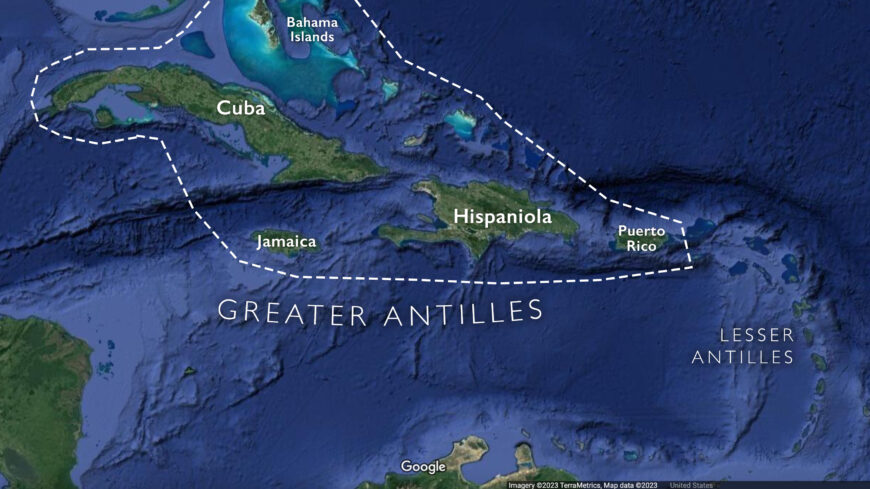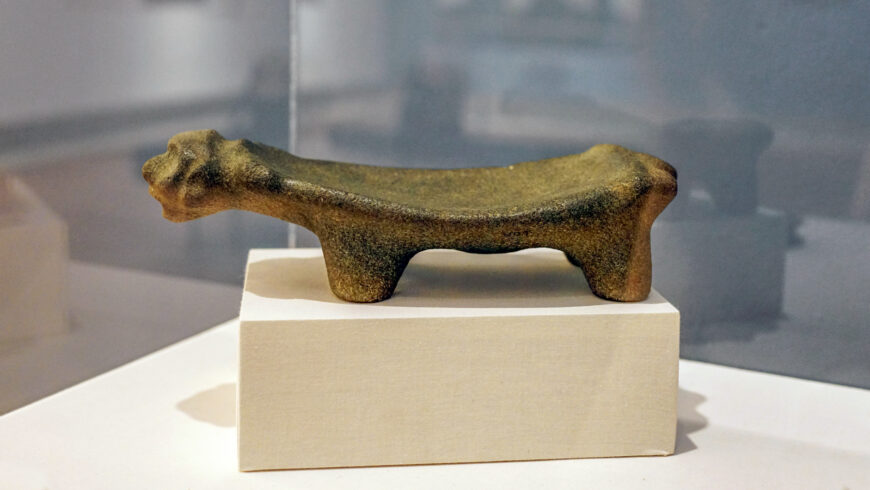
Duho, c. 1200–1500, Taíno, stone, Puerto Rico (Museo de Arte de Puerto Rico; photo: Dr. Lauren Kilroy-Ewbank, CC BY-NC-SA 2.0)
Taíno: natives of the Caribbean
Except for a few Spanish chronicles, such as Fray Ramón Pané’s Relación de las antigüedades de los indios (An Account of the Antiquities of the Indians, 1497), there are few written records of Taíno culture. Luckily, science has given important clues about the Taínos’ rise and decline, debunking the common misconception (known as the “myth of the Taino extinction”) that Taínos were wiped out by Spanish colonialism. In fact, Taíno descendants, along with their culture and language, remain an important part of Caribbean life today. Many Taíno words, such as canoe, hammock, and tobacco, still exist in today’s Spanish and English vocabulary. In places like the Dominican Republic and Puerto Rico, islanders proudly refer to themselves as “quisqueyanos” or “boricuas,” a reference to the Taíno name of their respective islands. In addition, new research by political scientists like Tony Castanha and biologists like Juan C. Martínez Cruzado have confirmed the legacy of Taíno culture in modern-day Puerto Rican society. Martínez Cruzado for example employed genetic testing to determine that 61.1% of Puerto Ricans carry Taíno ancestry. The Taíno then, remain central to understanding the history and the cultural diversity of the Caribbean.
The Taínos emerged c. 1200 C.E. They are descendants of the Arawaks who migrated from the northern coastal region of South America to the Caribbean where they settled in the Greater Antilles. While the Island Caribs (a different Indigenous people) resided in the Lesser Antilles, the Taínos, whose name translates into “good people,” occupied the islands of Hispaniola, Puerto Rico, Jamaica, the Bahamas, and Eastern Cuba. The Taínos were the first to come into contact with the Spanish when, in 1492, Christopher Columbus landed on the island of Hispaniola (today Haiti and the Dominican Republic), formerly known as Española, meaning “Spanish.”
The Taínos developed sophisticated systems of navigation, traversing the islands of the Caribbean with ease and building impressive wooden canoes, which the Spanish noted could fit up to 100 passengers. They were also known for their sophisticated agricultural system, cultivating three main crops—cassava (casaba), corn (mahiz), and sweet potatoes (batata)—in conucos (earth mounds) that are still used to this day. Similar to corn in Mesoamerica, cassava was the main staple of the Taíno diet, and as a result, rituals were implemented to celebrate the planting, harvesting, and consumption of this crop.
Social division
Taíno society was divided into two social classes, the naborias and nitaínos. The naborias were the laboring class in charge of fishing, hunting, and working in the conuco fields, while the nitaínos, the nobles, supervised their labor. The nitaínos ruled over communities known as yucayeques; and in turn, reported to a status group, the cacique—who oversaw the larger chiefdom of which yucayeques formed part. By 1492, there were five chiefdoms (caciques) on the island of Hispaniola.
Most Taínos lived modestly in bohios (huts) that were constructed from palm trees. The interior of these homes were furnished with stools, hammocks, and pots. The home of the cacique, called caney, was larger than traditional bohios and also served as a ceremonial center, containing religious objects, like zemís, made of wood, clay, or stone. Only caciques and ritual specialists would partake in these rituals through which they would communicate with the spiritual world for the purposes of divination or curing.
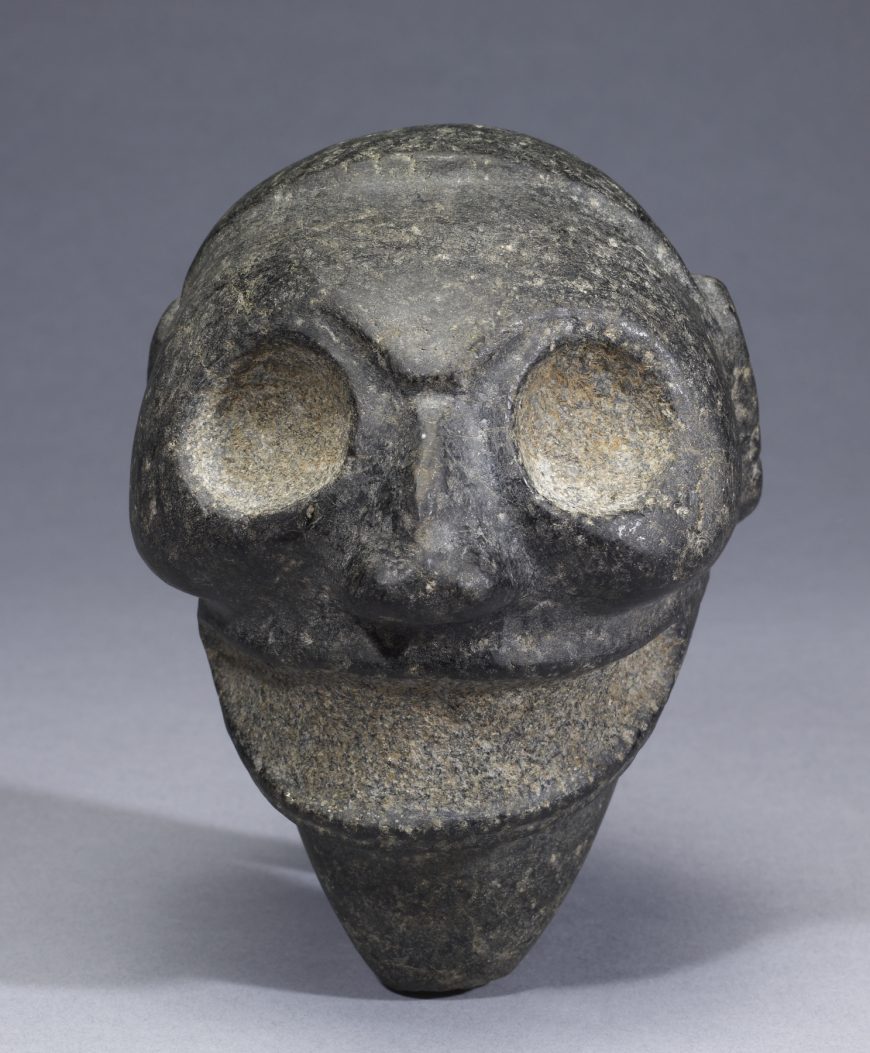
Taíno artist, Zemi, 800–1500 C.E., basalt stone, from the Dominican Republic (The Walters Museum)
Zemis and religion
The Taínos worshiped two main gods, Yúcahu, the lord of cassava and the sea, and Attabeira, his mother and the goddess of fresh water and human fertility. Yúcahu and Attabeira, as well as other lesser gods associated with natural forces, were worshiped in the form of zemís, sculptural figures that depicted either gods or ancestors. These objects often emphasized the head, as it was believed that the head was the location of spiritual power. Zemí figures could be used as stands, reliquaries, or as part of personal adornment.

Taíno artist, Zemí c. 1000 C.E., wood and shell, from the Dominican Republic (The Metropolitan Museum of Art)
While the zemís were perhaps the most important of Taíno artworks, there also existed numerous artifacts relating to the sniffing of cohoba, a powder derived from the seeds of a local tree, the Anadenanthera peregrina. The caciques and ritual specialists inhaled the cohoba, similar to how the Quimbaya from Colombia chewed coca leaves, for ritualistic purposes, in order to communicate with the spiritual world. The zemi sculpture above was made to hold cohoba for snuffing in the bowl atop its head. It shows a figure with an emaciated body and teary eyes; these mark the effects of someone who has been fasting prior to the cohoba ritual, and is now seeing into the spirit world through their wide-open eyes.
While the Taíno were matrilineal, meaning that the mother determined name and rank, their society was not matriarchal. In fact most caciques and nitaínos were men, although the women in their family held high status and enjoyed special privileges. Concerned with religious rituals, agricultural productivity, and maritime life, the Taíno, unlike the Aztecs of Mexico, were not well armed, leaving them ill-prepared for the arrival of the Spaniards— and their weapons.
The effects of the Spanish conquest
While Columbus set foot on the island of Hispaniola in 1492, conquest of the island did not begin until 1494. Quickly thereafter, exploratory missions took place throughout the Caribbean, with the Spanish colonization of Puerto Rico beginning in 1508 and Cuba in 1510. By 1509, only 15 years after the establishment of colonial rule in Hispaniola, the Taíno population is estimated at 60,000, a drop of hundreds of thousands in just a few years.
The dramatic collapse of the Taíno population—like that of other pre-Columbian cultures—was due to numerous factors, including overwork (a result of the encomienda system, the forced labor of indigenous people on plantations), disease (such as smallpox and measles, to which the indigenous populations were not immune), starvation, massacres, and suicide.
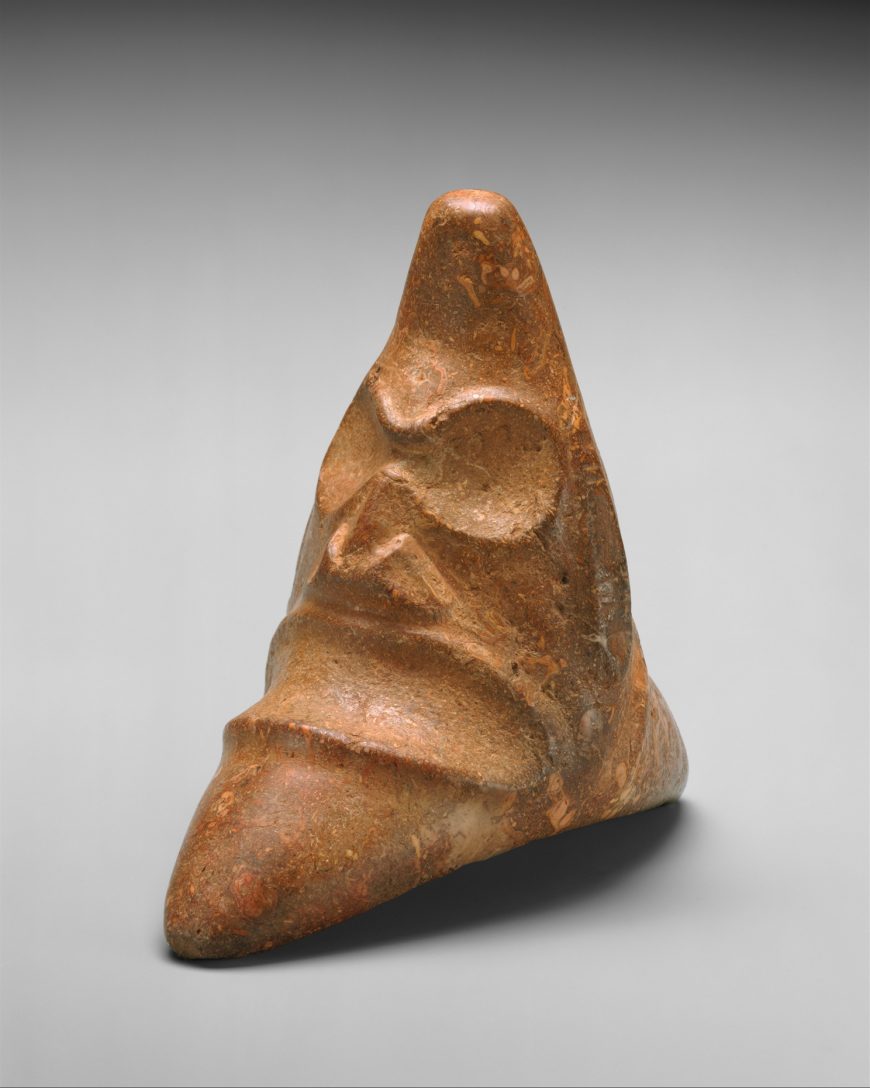
Taíno artist, Three-Cornered Stone (Trigonolito), 13th–15th century C.E., limestone, from the Dominican Republic (The Metropolitan Museum of Art)
Three-pointer stones and celts
Common objects produced by the Taíno include zemís, duhos (wooden ritual seats), three-pointer stones, and celts. Three-cornered stones can be small enough to hold in your hand or almost too heavy to carry. They typically include animal or human imagery, similar to the zemí featured above. On one three-cornered stone from The Metropolitan Museum of Art, a face with large eyes, a pointed nose, and a wide, open mouth can be seen.
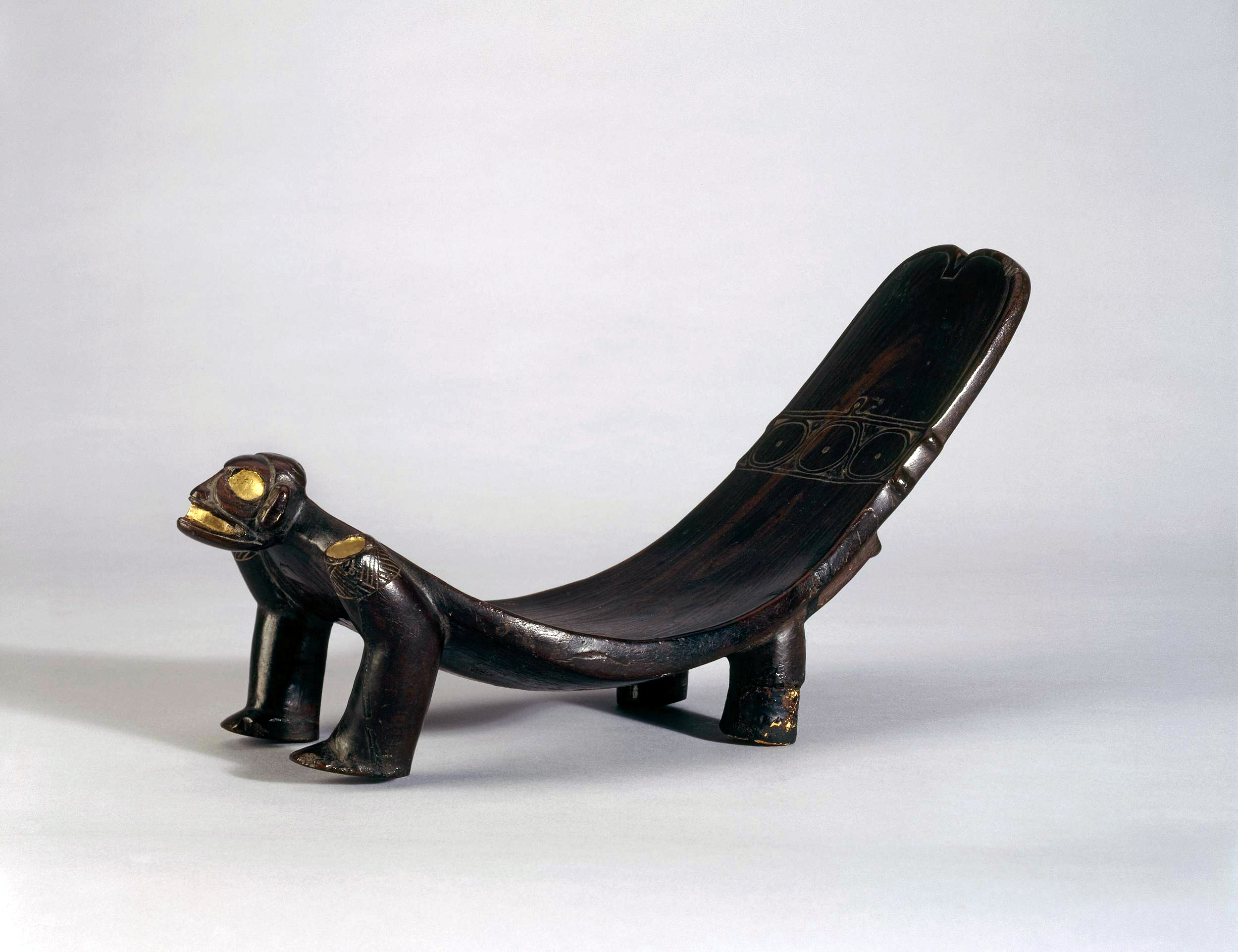
Taíno artist, Ritual seat (duho), 1292–1399, wood inlaid with gold, 22 x 44 x 16.5 cm (The British Museum)
Archeologists have discovered hundreds of three-pointer stones, suggesting they were common among the Taíno. Sometimes buried in conucos to promote agricultural fertility, these triangulated stones were also used to encourage human reproduction. Turn-of-the-twentieth-century American archaeologist Jesse Walter Fewkes categorized three-pointer stones into four categories, with the Three-Cornered Stone illustrated here being an example of the anthropomorphic type, characterized by a human face carved in the front. Certain facial features, such as the circular eyes and broad, open mouths, which also appear on zemís and duhos, and are typical of Taíno figurative sculpture.
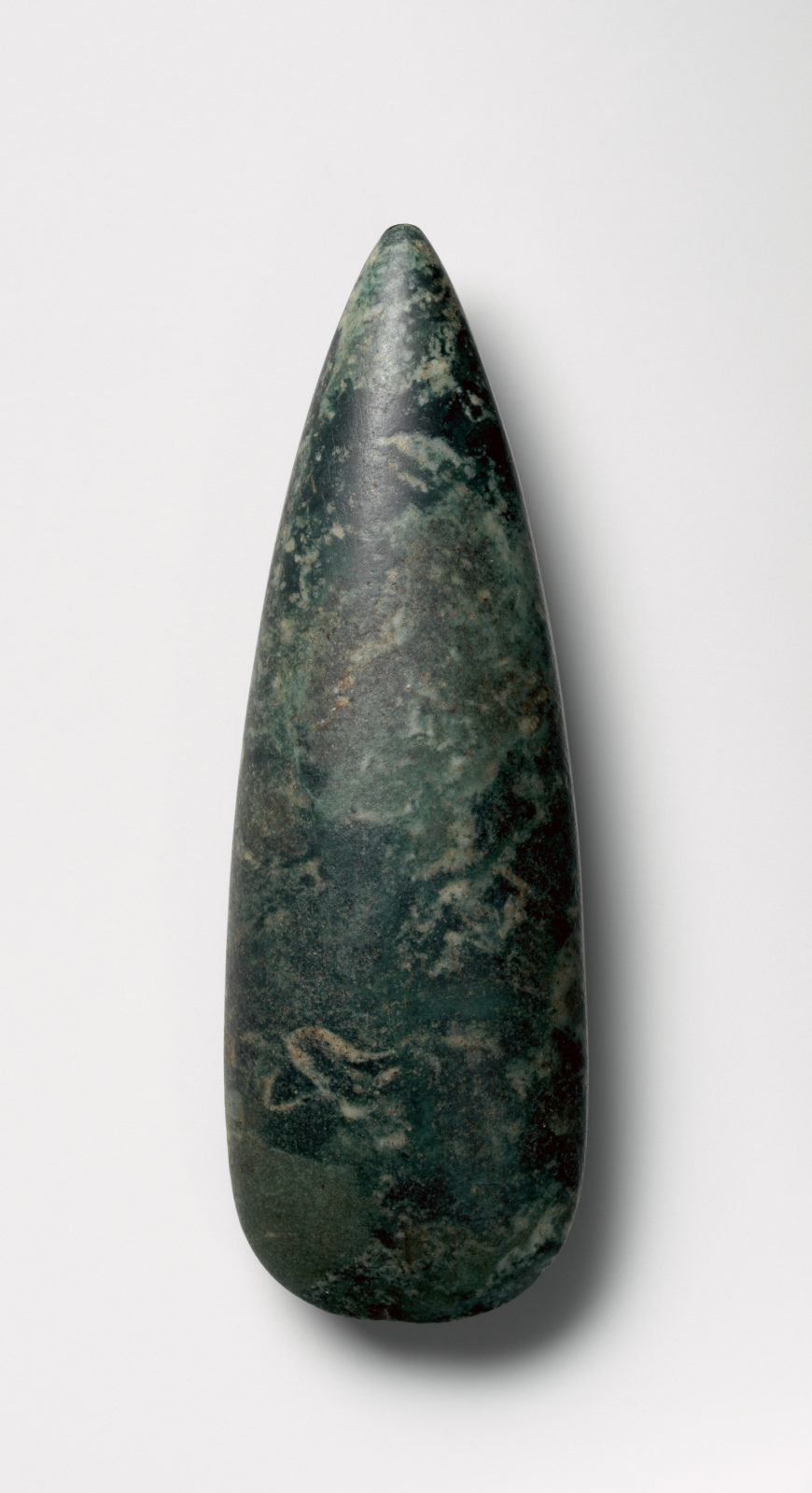
Ceremonial axe blade (celt), 7th-15th century C.E., greenstone (The Metropolitan Museum of Art)
A very common non-figurative object made by the Taíno are celts, which are ceremonial axe blades made of polished stone. Celts are common across the Caribbean, in the Mesoamerican, and the Isthmian mainland, where they were frequently carved into bird- and human-like forms. Taíno celts are are carved into lobed shape that is often compared to a flower petal, and they are polished until smooth. These celts were never meant to be used as axe blades, and instead were used as offerings to deities, symbols of status, and were also part of systems of exchange.
Together, these Taíno artworks, discovered in the Dominican Republic, Puerto Rico, and throughout the Greater Antilles, prove the existence of a Caribbean network of exchange, and the many ways in which the indigenous people of the Americas were interconnected even before 1492.

